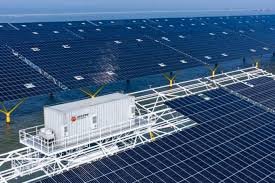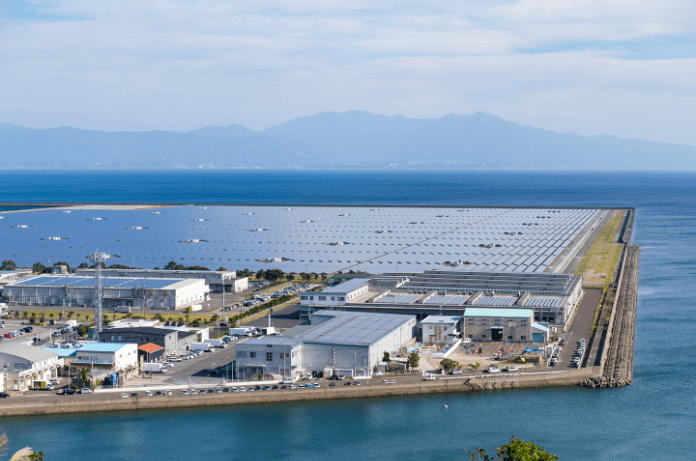CHN Energy’s 1-gigawatt offshore PV Project (Photovoltaic Project) in Kenli District, Shandong Province, eastern China, successfully connected its initial set of PV units to the grid. Developed by Guohua Energy Investment, a subsidiary of CHN Energy. The project boasts an installed capacity of 1GW and is recognized as the first and largest of its kind globally, setting a benchmark for future large-scale offshore PV projects.
This mega project is situated 8 kilometers off the coast of Dongying City, it spans about 1,223 hectares and comprises 2,934 PV platforms anchored with large offshore steel truss fixed-pile foundations.
Mega PV Project Location and Scale
Each platform is 60 meters long and 35 meters wide. Notably, it represents China’s first use of a 66-kilovolt offshore cable paired with an onshore cable for high-capacity, long-distance power transmission in the PV sector.
Once completed, the project is projected to produce 1.78 billion kilowatt-hours of electricity annually, sufficient to power approximately 2.67 million urban residents. The initiative also employs an integrated fishing and PV development model, blending fish farming with solar power generation to optimize marine area use.
Environmental Impact and Carbon Reduction
This would save an estimated 503,800 tons of standard coal and cut carbon dioxide emissions by 1.34 million tons.
JinkoSolar has provided its n-Type tunnel oxide passivated contact (TOPCon) Tiger Neo bifacial modules for the project, specially designed for harsh marine conditions. These modules feature dual-glass, semi-tempered glass, and POE encapsulation (a specialized material used in the construction of PV solar panels) to withstand moisture, salt corrosion, seawater, high winds, and extreme temperatures.
Earlier this week, CHN Energy connected its 3 GW Mengxi Lanhai solar facility to the grid, making it the second-largest solar project in China and worldwide. Currently, the largest completed offshore floating solar array is a 440 MW project in Taiwan, commissioned earlier this month. In May, China National Nuclear Corp, a state-owned enterprise, began construction of a 2 GW offshore solar plant off the coast of eastern Jiangsu Province, near the warm water discharge zone of the Tianwan nuclear plant.
Floating solar systems, involving modules installed on pontoons at sea level or platforms elevated above water, are viewed as a solution for space-constrained regions that still need local power generation.

A Blueprint for Sustainable Energy Solutions
CHN Energy’s 1-gigawatt offshore photovoltaic project in Shandong Province represents a pivotal moment for renewable energy innovation. Expected to power 2.67 million urban residents and significantly cut carbon emissions, this project underscores China’s leadership in sustainable practices and large-scale clean energy development. By combining solar energy generation with marine aquaculture, the project showcases a model for effective and comprehensive resource utilization.

